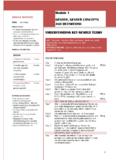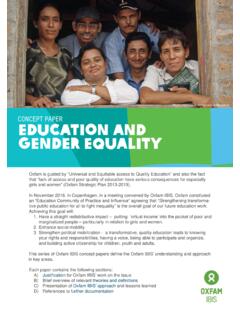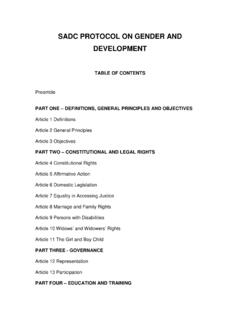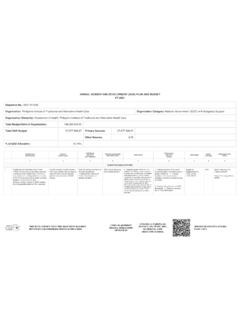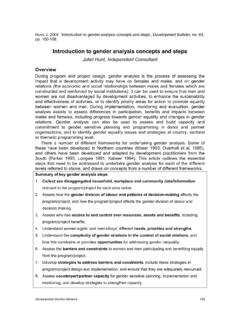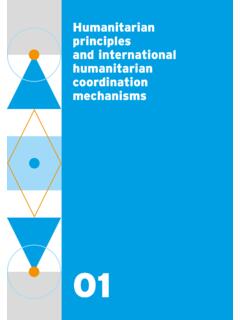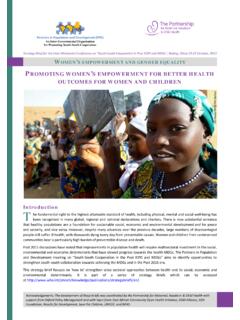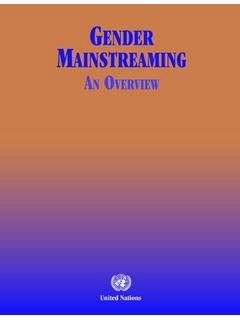Transcription of Promoting gender equality and women’s empowerment in ...
1 1 FAO/Jennifer Gee A woman sorting the catch at the dock in fact sheet presents an overview of current gender equality and women s empowerment issues in the fisheries sector. women s engagement in fisheries can be viewed from social, political and technical perspectives, all of which show that the role of women is often underestimated. This inadequate recognition of women s contributions hampers the sustainable development process, resulting in increased poverty and food insecurity. This fact sheet provides information on policy, institutions and planning processes; statistical dimensions in gender analysis; and specific concerns in the field of fisheries industries.
2 It identifies lessons learned and opportunities for gender mainstreaming at macro, meso and micro-operational information provided does not represent an exhaustive analysis of the subject, but suggests some relevant approaches for continuing the efforts made over the years in light of women s crucial role in sustainable fisheries and aquaculture development. Promoting gender equality and women s empowerment in fisheries and aquacultureWhy consider gender issues in the fisheries sector?In the fisheries sector, men and women engage in distinct and often complementary activities that are strongly influenced by the social, cultural and economic contexts they live in.
3 Male-female relations vary greatly and are based on economic status, power relations, and access to productive resources and most regions, fish catching is male-dominated. Ocean-going boats for offshore and deep-sea fishing have male crews, while in coastal artisanal fishing communities women often manage smaller boats and canoes. women are mostly responsible for skilled and time-consuming onshore tasks, such as making and mending nets, processing and marketing catches, and providing services to the boats. In western Africa and Asia, as much as 60 percent of seafood is marketed by women , and in many parts of the world they also do a significant amount of shellfish gathering/clam gleaning a fishery activity that is often under-recognized, or not recognized at statistical systems (such as those for fisheries)
4 Commonly fail to capture these broader contributions to livelihoods, nor do they consider women s engagement in fishery/shellfish harvesting activities Employment in the fisheries sectorAccording to The State of World Fisheries and Aquaculture published in 2016 by FAO, in the period 2005 2014, the quality and frequency of reporting on engagement by gender improved slowly. It is estimated that, overall, women accounted for more than 19 percent of all people directly engaged in the fisheries and aquaculture primary sector in 2014.
5 A recent publication estimates that, globally, when primary and secondary fisheries sector engagements are combined, women make up half of the workforce. As reporting improves and policies directed at increasing women s decision-making capacities in the sector develop, it is expected that both reporting and actual engagement of women in the sector will increase. FAO estimates that, overall, fisheries and aquaculture assure the livelihoods of 10 12 percent of the world s population (FAO, 2014b).2 Selling fish at the market in Lisbon, Portugal.
6 (as the products are often not sold through a formal market system, may not be of high value, or may be used for home consumption). In addition, women may not self-report/identify as being fishers even though they are engaged in these fisheries value chains men and women have distinct roles, and their socio-economic status influences their power relations. women and men can have dominant roles, or they can be in positions of high dependency. women constitute about half the population involved in fisheries development activities.
7 In some developing regions women have become important fish entrepreneurs who control significant amounts of money, finance a variety of fish-based enterprises, and generate substantial returns for households and communities. Worldwide, the fisheries and aquaculture sector provides direct employment and revenue to an estimated 180 million or more certain countrie s of West Africa ( Ghana, the Niger, Benin and the Gambia), women are traditionally engaged in low-paid jobs, such as unloading the day s catch to be carried to the beach or fish-smoking huts; drying and processing the fish; and converting fish waste into useful products.
8 Compared with men, women often face more problems related to technology, finance for enterprise expansion, and transport. Their plight is worsened at the market level where they encounter price fluctuations for their products, or where social and/or cultural pressures limit their market opportunities to locations that are close to home. If women are able to access local markets, they may still be unable to access the national or global markets that men have access to. They often assume responsibility for their families daily subsistence needs, which sometimes drastically depletes their working capital.
9 In the inland fisheries of many countries women are engaged in fishing and are taking a leading role in the rapid growth of aquaculture. They own and manage fishing boats and have their own fishing gear. In aquaculture, women often carry out most of the work of feeding, harvesting and processing fish and shellfish. They can become managers of small household enterprises, such as fish ponds, and thus improve their families income and nutrition. However, women tend to have limited control over ponds and inputs for aquaculture, so they rarely participate in production beyond satisfying their household needs.
10 When aquaculture production intensifies, it increases the labour burdens on women and youth, affecting their production, productivity and welfare. As most fisheries activities are seasonal and influenced by the status of the resources, many fishing communities have diversified their livelihoods. Depending on the status of their household, women and men engage in other economic activities such as vegetable gardening or farming to augment their family incomes, as is seen in Benin, Cambodia, the Congo, Ghana, Nigeria and mayors of villages in the PhilippinesIn the coastal areas of the Philippines, people have distinct gender roles similar to those in many African and Asian countries.










